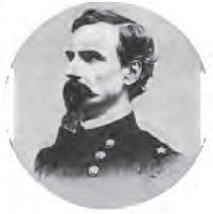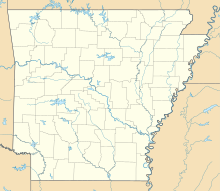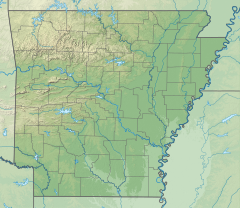Little Rock campaign
| Little Rock campaign | |
|---|---|
| Part of the American Civil War | |
| Operational scope | Strategic offensive |
| Location | 34°43′19″N 92°12′05″W / 34.72194°N 92.20139°W |
| Commanded by | |
| Objective | Capture of Little Rock |
| Date | August 1 – September 14, 1863 |
| Executed by | "Arkansas Expedition" |
| Outcome | Union victory |
Location of Little Rock within Arkansas | |
The Little Rock Campaign (August 1 – September 14, 1863), officially known as Advance of the Union forces upon Little Rock, Arkansas, was a campaign conducted by the Union Army in Arkansas during the American Civil War. The offensive was designed to capture Little Rock.
Union forces led by Major General
The overall Confederate commander, Major General
Overview
After the American Civil War opened with
Confederate troops commanded by Lieutenant General
Expecting a Union offensive,
Opposing forces
Confederate
The following Confederate States Army units and commanders fought in the Little Rock campaign.
Abbreviations used
Military rank
- LTG = Lieutenant General
- MG = Major General
- BG = Brigadier General
- Col = Colonel
- Ltc = Lieutenant Colonel
- Maj = Major
- Cpt = Captain
Other
- w = wounded
- mw = mortally wounded
- k = killed
District of Arkansas
| Division | Brigade | Regiments and others |
|---|---|---|
|
Price's Division
James F. Fagan[17]
BG Daniel M. Frost[18][19] |
First Brigade |
|
| Second Brigade
|
| |
| Third Brigade
James C. Tappan[21] Returned to Little Rock, from Louisiana, August 20, 1863, held in reserve south of Arkansas River. |
| |
| Fourth Brigade
Mosby M. Parsons
|
| |
| Frost's Brigade, a.k.a. Clark's Brigade
John B. Clark[23]
Moved from Fort Pleasant at Pine Bluff and joining Little Rock Defenses on August 17, 1863. |
| |
|
Walker's Division
|
Dobbins's Arkansas Cavalry Brigade
|
|
| Carter's Texas Cavalry Brigade
|
| |
|
Marmaduke's Division
|
Shelby's Iron Brigade
Jo Shelby[26] Col Benjamin F. Gordon |
|
| Second Brigade
|
|
The campaign
Early maneuvers
Steele's men left Helena on August 10 and 11.
Steele's men suffered during their march to Clarendon from heat, heavy dust, and contaminated water. They began to reach Clarendon on August 15, but conditions there were not much better.[35] Within two days, over a thousand of Steele's men were sick.[11] On August 22, Steele sent Davidson towards Little Rock with his cavalry, while Steele and the infantry moved beginning on the next day to set up an operations hub at DeValls Bluff, which was hoped to be a healthier area.[36] Meanwhile, Price removed Fagan from command and replaced him with Brigadier-General Daniel M. Frost.[37] He also grouped Walker's and Marmaduke's cavalry together, under the command of the former. This exacerbated tensions between Walker and Marmaduke, which had formed during the fighting at Helena.[38]
Brownsville and Bayou Meto

Walker and Marmaduke formed a plan where Walker and some of his men would hold back in a woodline west of Brownsville, while Marmaduke would try to use a
Price began to doubt that Little Rock could be defended, so he had supplies transferred to Arkadelphia and started preparations for the evacuation of the city.[33] Union captures of Fort Smith, Arkansas and Monroe, Louisiana had already disrupted Confederate communications to the south and west.[42] Minor skirmishing occurred on August 26 as Davidson sent patrols to scout the Confederate position at Bayou Meto and Shallow Ford further to the south.[43] Davidson's cavalry attacked Confederate position the next day, bringing on the Battle of Bayou Meto.[40] Union troops drove Confederate skirmishers back across the bayou, and the Confederates burned Reed's Bridge, the only nearby crossing. Union cavalry made more advances, likely to rescue the wounded, but most of the rest of the fighting was an artillery duel. A Confederate unit, Bell's Missouri Battery, was wrecked during the action, leading Marmaduke to group all his artillery together with the aim of retaliating against the Union guns with concentrated fire.[44] The Confederate right was weak, but was not strongly attacked. That night, the Union troops withdrew to Brownsville, and the Confederates to within 5 miles (8.0 km) of Little Rock. The fighting on August 27 cost the Union seven men killed and 38 wounded, while Confederate losses were not reported.[45] Castel believes that by not making a stronger stand at Bayou Meto, Price lost his best chance to defeat Steele.[42]
Crossing the Arkansas

The next several days saw little fighting. Davidson had a detachment scout down the road to Shallow Ford on August 29,[46] and the next day, Davidson's advance guard skirmished with some of Newton's Confederate cavalry.[47] More skirmishing between Davidson's men and Newton's command occurred on August 31, but Newton withdrew most of his men to Ashley's Mills on September 1. The brigade of Colonel James M. True had joined Steele on August 30,[48] bringing the total Union strength to about 15,000 men.[47] Steele arrived at Brownsville with the infantry on the next day; the Union forces spent the next three days scouting.[49] Price had fewer than 8,000 men with which to defend Little Rock; about 6,500 were in the fortifications across the river and the rest were mainly cavalry with Walker guarding river crossings south of the city.[47]
On September 6, the Union troops crossed Bayou Meto at Shallow Ford and began moving towards Ashley's Mills to cross the Arkansas River there, a route that would bypass Price's fortifications.
Evacuation of Little Rock
With Union forces across the Arkansas River, Price withdrew his men from their entrenchments on the northern side, and began to evacuate the city,
As Davidson's men approached, they were separated into two wings by the bayou, with the right commanded by Colonel
The action at Bayou Fourche cost the Union seven men killed and sixty-four wounded.[63] No fighting occurred north of the Arkansas River, although two Union artillerymen serving a battery accompanying the infantry were wounded by an accidental explosion. Price's men burned bridges, railroad equipment, and the gunboat CSS Pontchartrain.[64] The last of the Confederates were out of the city by 5:00 pm, and Little Rock's civilian government surrendered the city to the Union two hours later. The Confederates fell back to Arkadelphia;[63] Merrill led two brigades on a halfhearted pursuit on September 11.[65] An attempt to resume the pursuit the next day found that the Confederate rear guard had gotten away. Steele criticized Merrill's handling of the retreat.[66] Union troops captured five cannons, 3,000 pounds (1,400 kg) of gunpowder, and many cartridges in the city. Steele's losses were 18 men killed, 118 wounded, and one man missing; the Confederates reported 12 men killed, 34 wounded, and 18 captured or missing although this figure is based on incomplete reporting and the true number is higher.[67] Both sides's figures exclude deaths due to disease, and the Confederates abandoned 650 sick and wounded in Little Rock.[68] Many Confederate troops deserted during the retreat;[69] historian Carl Moneyhon estimates the number of desertions as 1,900.[70]
Aftermath
Historian Mark Christ states that Steele "achieved a remarkable victory" and states that the only criticism of Steele's campaign was his failure to strongly pursue. Christ also quotes historian
Steele placed Davidson in command of the defense of the city, ordered the construction of defensive positions south of the city, had
See also
- Lists of American Civil War Regiments by State
- Arkansas in the American Civil War
- Arkansas Militia in the Civil War
References
Citations
- ^ Christ 2010, pp. 12–13.
- ^ Christ 2010, pp. 18–22.
- ^ Christ 2010, pp. 22–24.
- ^ Christ 2010, pp. 26–28.
- ^ Kennedy 1998, pp. 175–176.
- ^ DeBlack 1994, p. 89.
- ^ Christ 2010, p. 155.
- ^ Huff 1963, p. 225.
- ^ a b Huff 1963, p. 227.
- ^ Huff 1963, p. 226.
- ^ a b c DeBlack 1994, p. 90.
- ^ Huff 1963, pp. 226–227.
- ^ Kerby 1972, p. 227.
- ^ Christ 2010, pp. 150–151.
- Theophilus H. Holmesbeing absent, sick
- ^ "The Division-Defending Little Rock-August 25-Sep.10,1863" by Timothy W Burford & Stephanie McBride.1999 and 2000.
- ^ Until August 17, 1863, when Frost's Brigade joined the Division
- ^ Assumed Command August 17, 1863, by General Orders No.11
- ^ OR Series 1, Vol.22, Part 2 p.969, Accessed 23 July 2013 at Arkansas in the Civil War Message Board, http://history-sites.com/cgi-bin/bbs62x/arcwmb/webbbs_config.pl?page=1;md=read;id=28394
- ^ vice Col Samuel S. Bell, captured at Helena)
- ^ War Dept, United States (1888). "The War of the Rebellion: A Compilation of the Official Records of the Union and Confederate Armies".
- ISBN 978-1-55728-870-7.
- ^ Taylor, Doyle, "Re: Aug/Sep 1863 – CS Order of Battle" Arkansas in the Civil War Message Board, Posted 5/13/2004, Accessed 23 July 2013, http://www.history-sites.com/cgi-bin/bbs62x/arcwmb/arch_config.pl?md=read;id=7340
- ^ relieved 10 September 1863
- ^ PARSONS'S BRIGADE, The Handbook of Texas, accessed 23 July 2013, https://www.tshaonline.org/handbook/online/articles/qkp01
- ^ ill until Sept. 10th
- ^ vice Col Colton Greene
- ^ Castel 1993, p. 154.
- ^ Christ 2010, p. 151.
- ^ a b Huff 1963, p. 228.
- ^ Christ 2010, pp. 151–153.
- ^ Christ 2010, p. 153.
- ^ a b c Huff 1963, p. 229.
- ^ Christ 2010, p. 154.
- ^ Christ 2010, pp. 156–158.
- ^ Christ 2010, pp. 160, 162.
- ^ Huff 1963, pp. 229–230.
- ^ a b Christ 2010, p. 162.
- ^ a b Christ 2010, p. 164.
- ^ a b c DeBlack 1994, p. 91.
- ^ Christ 2010, pp. 162–165.
- ^ a b Castel 1993, p. 155.
- ^ Christ 2010, p. 165.
- ^ Christ 2010, pp. 166–169.
- ^ Christ 2010, pp. 169–170.
- ^ Christ 2010, pp. 170–171.
- ^ a b c Huff 1963, p. 231.
- ^ Christ 2010, p. 171.
- ^ DeBlack 1994, p. 92.
- ^ Christ 2010, p. 173.
- ^ Huff 1963, p. 232.
- ^ Christ 2010, p. 175.
- ^ Christ 2010, pp. 175–176.
- ^ Huff 1963, pp. 233–234.
- ^ DeBlack 1994, pp. 93–94.
- ^ Castel 1993, p. 156.
- ^ Christ 2010, p. 179.
- ^ Christ 2010, pp. 197–180.
- ^ Huff 1963, p. 234.
- ^ Christ 2010, pp. 180–181.
- ^ Christ 2010, pp. 182–184.
- ^ Christ 2010, pp. 184–186.
- ^ a b DeBlack 1994, p. 94.
- ^ Christ 2010, p. 188.
- ^ Huff 1963, p. 235.
- ^ Christ 2010, pp. 193–194.
- ^ Huff 1963, pp. 235–236.
- ^ Christ 2010, pp. 194–195.
- ^ DeBlack 1994, pp. 94–95.
- ^ Christ 2010, p. 195.
- ^ Christ 2010, p. 196.
- ^ Castel 1993, p. 160.
- ^ Kerby 1972, p. 229.
- ^ Huff 1963, pp. 236–237.
- ^ Christ 2010, p. 194.
- ^ Cutrer 2017, p. 267.
- ^ Christ 2010, pp. 195–196.
- ^ Kerby 1972, pp. 231–232.
- ^ Kerby 1972, p. 233.
- ^ Kerby 1972, pp. 233–236.
- ^ Kennedy 1998, p. 233.
- ^ Shea 1982, pp. 318–319.
- ^ Shea 1982, pp. 321–322.
- ^ Kennedy 1998, pp. 274–275.
- ^ Kennedy 1998, p. 275.
- ^ Kennedy 1998, pp. 380–386.
- ^ Kennedy 1998, p. 438.
- ^ Schnelder, Jack (August 20, 2019). "Arkansas Sightseeing: Civil War history marked along trail". Arkansas Democrat-Gazette. Archived from the original on October 23, 2022. Retrieved October 23, 2022.
Bibliography
- ISBN 0-8071-1854-0.
- Christ, Mark K. (2010). Civil War Arkansas 1863: The Battle for a State. Norman, Oklahoma: ISBN 978-0-8061-4433-7.
- Cutrer, Thomas W. (2017). Theater of a Separate War: The Civil War West of the Mississippi River 1861–1865. Chapel Hill, North Carolina: University of North Carolina Press. ISBN 978-1-4696-3156-1.
- DeBlack, Thomas A. (1994). "1863: "We Must Stand or Fall Alone"". In Christ, Mark K. (ed.). Rugged and Sublime: The Civil War in Arkansas. Fayetteville, Arkansas: University of Arkansas Press. ISBN 1-55728-356-7.
- Huff, Leo E. (1963). "The Union Expedition Against Little Rock, August–September, 1863". JSTOR 40007662.
- Kennedy, Frances H., ed. (1998). The Civil War Battlefield Guide (2nd ed.). Boston/New York: Houghton Mifflin. ISBN 978-0-395-74012-5.
- Kerby, Robert L. (1972). Kirby Smith's Confederacy: The Trans-Mississippi South, 1863–1865 (University of Alabama paperback ed.). Tuscaloosa, Alabama: University of Alabama Press. ISBN 0-8173-0546-7.
- Shea, William L. (1982). "The Camden Fortifications". JSTOR 40038521.
External links
- Community & Conflict: The Impact of the Civil War In the Ozarks
- Edward G. Gerdes Civil War Home Page
- The Encyclopedia of Arkansas History and Culture
- The War of the Rebellion: a Compilation of the Official Records of the Union and Confederate Armies
- The Arkansas History Commission, State Archives, Civil War in Arkansas


